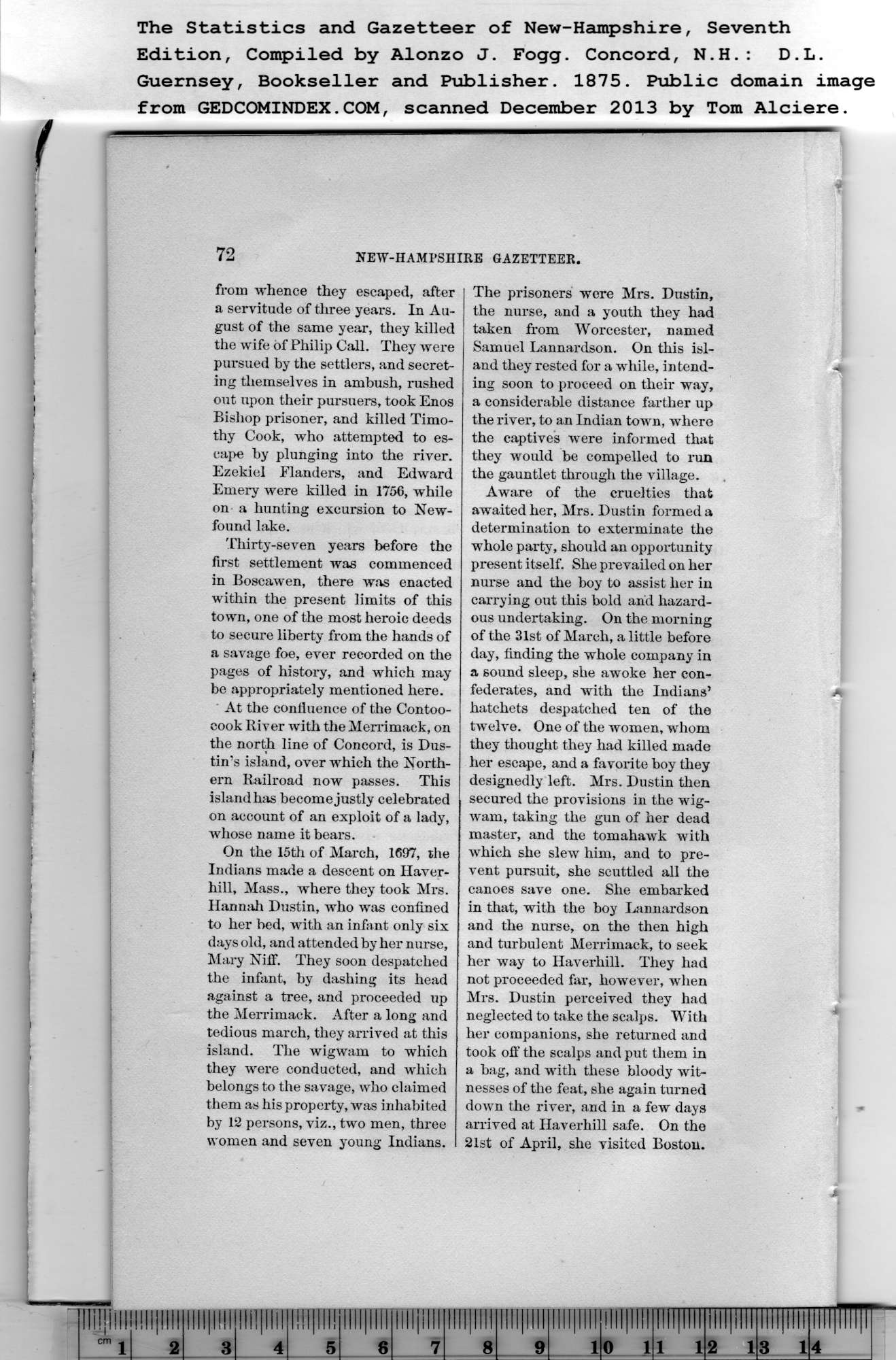|
from whence they escaped, after
a servitude of three years. In Au-
gust of the same year, they killed
the wife of Philip Call. They were
pursued by the settlers, and secret-
ing themselves in ambush, rushed
out upon their pursuers, took Enos
Bishop prisoner, and killed Timo-
thy Cook, who attempted to es-
cape by plunging into the river.
Ezekiel Flanders, and Edward
Emery were killed in 1756, while
on a hunting excursion to New-
found lake.
Thirty-seven years before the
first settlement was commenced
in Boscawen, there was enacted
within the present limits of this
town, one of the most heroic deeds
to secure liberty from the hands of
a savage foe, ever recorded on the
pages of history, and which may
be appropriately mentioned here.
At the confluence of the Contoo-
eook River with the Merrimack, on
the north line of Concord, is Dus-
tin’s island, over which the North-
ern Railroad now passes. This
island has become justly celebrated
on account of an exploit of a lady,
whose name it bears.
On the 15th of March, 1697, the
Indians made a descent on Haver-
hill, Mass., where they took Mrs.
Hannah Dustin, who was confined
to her bed, with an infant only six
days old, and attended by her nurse,
Mary Niff. They soon despatched
the infant, by dashing its head
against a tree, and proceeded up
the Merrimack. After a long and
tedious march, they arrived at this
island. The wigwam to which
they were conducted, and which
belongs to the savage, who claimed
them as his property, was inhabited
by 12 persons, viz., two men, three
women and seven young Indians. |
The prisoners were Mrs. Dustin,
the nurse, and a youth they had
taken from Worcester, named
Samuel Lannardson. On this isl-
and they rested for a while, intend-
ing soon to proceed on their way,
a considerable distance farther up
the river, to an Indian town, where
the captives were informed that
they would be compelled to run
the gauntlet through the village.
Aware of the cruelties that
awaited her, Mrs. Dustin formed a
determination to exterminate the
whole party, should an opportunity
present itself. She prevailed on her
nurse and the boy to assist her in
carrying out this bold and hazard-
ous undertaking. On the morning
of the 31st of March, a little before
day, finding the whole company in
a sound sleep, she awoke her con-
federates, and with the Indians’
hatchets despatched ten of the
twelve. One of the women, whom
they thought they had killed made
her escape, and a favorite boy they
designedly left. Mrs. Dustin then
secured the provisions in the wig-
wam, taking the gun of her dead
master, and the tomahawk with
which she slew him, and to pre-
vent pursuit, she scuttled all the
canoes save one. She embarked
in that, with the boy Lannardson
and the nurse, on the then high
and turbulent Merrimack, to seek
her way to Haverhill. They had
not proceeded far, however, when
Mrs. Dustin perceived they had
neglected to take the scalps. With
her companions, she returned and
took off the scalps and put them in
a bag, and with these bloody wit-
nesses of the feat, she again turned
down the river, and in a few days
arrived at Haverhill safe. On the
21st of April, she visited Boston. |
